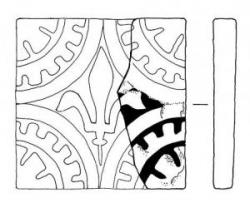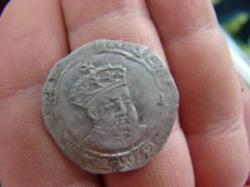- 30 AOÛT
- INDI-UNI : 
PRE-INSCRIPTION : 15 Juin – 31 Août
PRE-REGISTRATION: June 15th - August 31st
- RUSSIE - Veliky Novgorod - During excavations in Veliky Novgorod, north-west of Moscow, archaeologists found a fragment of an old musical instrument which might be 1,000 years old. The fragment is the head of a wooden three-string bow instrument resembling a violin. Archaeologists date the instrument back to the middle of the 10th century. Archaeological excavations began in that place 11 years ago and only this year 248 artefacts were found.
http://english.ruvr.ru/2011/08/27/55272236.html
- CHINE – Chifeng - A 5,000-year old rock carving in north China's Inner Mongolia Autonomous Region depicts a falling meteor, said archaeologists on Saturday. A rock on the side of Dahei Mountain in the city of Chifeng has images of people, domed houses and a fire ball with a long tail falling from the sky engraved on it, said Wu Jiacai, head of the Inner Mongolia rock paintings protection association. "I believe it shows prehistoric people returning at dusk from a hunting trip to their domed houses, as a meteor falls from the sky."
He added that in the same location several years ago, another set of carvings were found showing people fleeing, snakes slithering and birds flying away, which might be what happened after the meteor hit the earth. The area has about 1000 carvings all believed to be made by the Neolithic Hongshan people, Wu said. "The pictures can shed some light on the disappearance of the Hongshan culture, which was quite developed," Wu said.
http://www.kaogu.cn/en/detail.asp?ProductID=3040
- JAPON –  Mabuni Hantabaru - Researchers have unearthed an ancient forearm bone from the Mabuni Hantabaru archeological site in Itoman, Okinawa Prefecture, believed to be from a Jomon period male roughly 169 centimeters tall -- much taller than the average for the period. The bone, measuring about 28 centimeters, is believed to be from the late Jomon period, dating back 3,000-4,000 years. The average height of males from the same period is about 158 centimeters. The survey of the site in Itoman, believed to be a burial ground, was conducted in collaboration with the Itoman Municipal Board of Education between 2007 and 2010. So far the bones of 85 people have been unearthed at the site. In a lower layer, the forearm bone -- believed to be the ulna of an adult male -- was found practically undamaged. The bone is thick, indicating that it was from a person of solid build. The 169-centimeter estimated height of the person is the tallest among the Jomon period specimens found in Kyushu and Okinawa. The bones of another male estimated to be 164 centimeters tall have also been unearthed at the site. However, Matsushita said with only two samples of relatively tall people being found, there was no evidence that their height had been passed on genetically. "It may have been a result of individual variation, or the bones may have been from someone outside the Mabuni group. We want to see if there are any other instances of the bones of tall people being found in the prefecture," Matsushita said.
Mabuni Hantabaru - Researchers have unearthed an ancient forearm bone from the Mabuni Hantabaru archeological site in Itoman, Okinawa Prefecture, believed to be from a Jomon period male roughly 169 centimeters tall -- much taller than the average for the period. The bone, measuring about 28 centimeters, is believed to be from the late Jomon period, dating back 3,000-4,000 years. The average height of males from the same period is about 158 centimeters. The survey of the site in Itoman, believed to be a burial ground, was conducted in collaboration with the Itoman Municipal Board of Education between 2007 and 2010. So far the bones of 85 people have been unearthed at the site. In a lower layer, the forearm bone -- believed to be the ulna of an adult male -- was found practically undamaged. The bone is thick, indicating that it was from a person of solid build. The 169-centimeter estimated height of the person is the tallest among the Jomon period specimens found in Kyushu and Okinawa. The bones of another male estimated to be 164 centimeters tall have also been unearthed at the site. However, Matsushita said with only two samples of relatively tall people being found, there was no evidence that their height had been passed on genetically. "It may have been a result of individual variation, or the bones may have been from someone outside the Mabuni group. We want to see if there are any other instances of the bones of tall people being found in the prefecture," Matsushita said.
http://mdn.mainichi.jp/mdnnews/news/20110830p2a00m0na003000c.html
- ROYAUME UNI –
 Enfield – Archaeologists have unearthed a piece of Enfield history on a dig at the former palace of Henry VIII. An excavation around the site, on the grounds of Forty Hall, where Elsyng Palace once sat, has uncovered a fragment of one of the first high status glazed English tiles used by the rich to show off their importance. Archaeologist Dr Martin Dearne, who has been part of the dig, said the discovery showed the site was noteworthy even before the king’s notorious rule. He said: “We knew the Elsyng site became the royal palace but we don’t know about its importance early on. We now know it had been important for hundreds of years. “The assumption has got to be that it would have been an important manor house.” He said it would likely have been home to a lord controlling the surrounding area. The tile was made in Penn, in Buckinghamshire, between 1350 and 1390, and is the second big discovery of the dig. The team also found a silver coin, known as a half groat, worth the equivalent of around £20, with Henry VIII’s face on it
Enfield – Archaeologists have unearthed a piece of Enfield history on a dig at the former palace of Henry VIII. An excavation around the site, on the grounds of Forty Hall, where Elsyng Palace once sat, has uncovered a fragment of one of the first high status glazed English tiles used by the rich to show off their importance. Archaeologist Dr Martin Dearne, who has been part of the dig, said the discovery showed the site was noteworthy even before the king’s notorious rule. He said: “We knew the Elsyng site became the royal palace but we don’t know about its importance early on. We now know it had been important for hundreds of years. “The assumption has got to be that it would have been an important manor house.” He said it would likely have been home to a lord controlling the surrounding area. The tile was made in Penn, in Buckinghamshire, between 1350 and 1390, and is the second big discovery of the dig. The team also found a silver coin, known as a half groat, worth the equivalent of around £20, with Henry VIII’s face on it
http://www.enfieldindependent.co.uk/news/localnews/9222336.Tile_sheds_light_on_centuries_of_Elsyng_Palace_history/
- USA - Fort Hawkins - From Oct. 10 to 28, archaeologists from The Lamar Institute in Savannah will renew their 2005 dig at Fort Hawkins, the 1806 frontier post that predated the city by 17 years. The previous excavation uncovered the east wall and half the south side of the wooden palisade that surrounded the fort, said Marty Willett, project coordinator for the city’s Fort Hawkins Commission. In addition to discovering that the fort was diamond-shaped rather than square, the 2005 dig found the sites of half a dozen substantial buildings and more than 30,000 artifacts, he said. The dig this fall will trace the remaining outer walls, culminating with the fort’s northwestern blockhouse, he said. “It blew over in a windstorm in 1871,” Willett said.
http://www.macon.com/2011/08/30/1682861/volunteers-sought-to-help-dig.html#ixzz1WWaJ1k3E
- CANADA – Arctic - Archeologists in the Arctic hoping to find Sir John Franklin's long-lost ships neared the end of their latest search Friday with no shipwreck in sight. It appears HMS Erebus and HMS Terror, two of the most sought-after wrecks in Canada, will remain undiscovered for now. Parks Canada archeologists spent the last six days combing an area west of King William Island, in Nunavut where explorers seeking the Northwest Passage stopped or, in the case of Franklin, got stranded in ice. Erebus and Terror vanished in the High Arctic more than 160 years ago, along with the famous British explorer and 128 crew. This was the third year of a three-year-program to find Erebus and Terror, but searches for the two ships and remnants of Franklin's failed 1845 expedition began almost immediately after he disappeared.
http://www.alaskadispatch.com/article/archaeologists-out-luck-latest-quest-unearth-famed-arctic-shipwreck
- USA – Portland - Excavations now under way around the Abyssinian Meeting House are part plumbing project, part historical rescue mission, part archaeological study. The archaeological dig, launched last Wednesday, comes as a volunteer committee is seeking to redirect water that's entering the historic building from an underground spring. "We're putting in a drainage system" to prevent the spring from degrading the building's interior, explained Leonard Cummings, chair of the executive committee of the Committee to Restore the Abyssinian Meeting House. The word "Abyssinia" refers to a region of Africa in ancient times. Constructed between 1828 and 1831 to serve Portland’s African American community, the Abyssinian Meeting House is one of only three of its kind still standing in the United States.
http://portlanddailysun.me/node/27978/